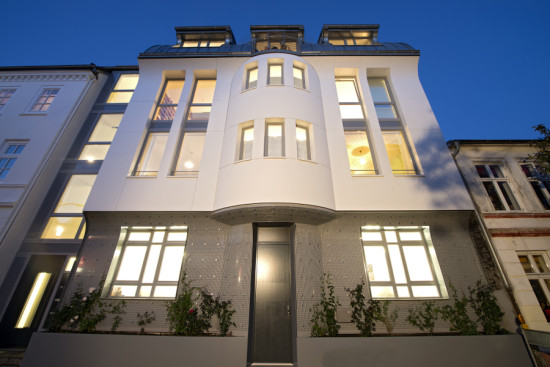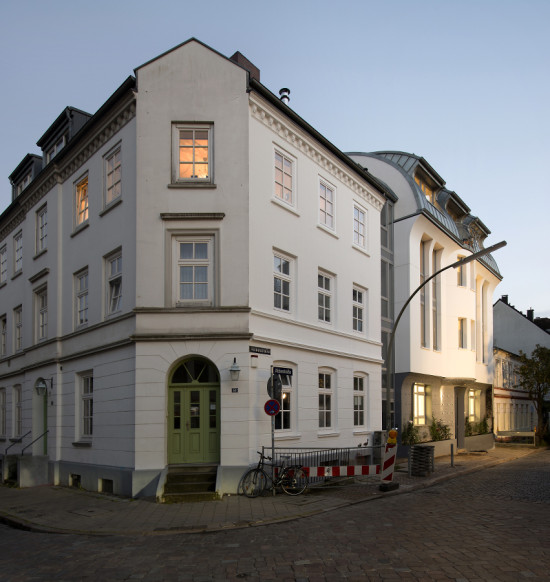
Composite facade brings new row house into harmony with its historic neighbors.
Florian Köhler, whose firm, Köhler Architekten, recently designed and built a new row house in Hamburg’s Ottensen quarter, observes a disheartening trend among his fellow architects. When designing for a site rich in historic context, they tend to shy away from all allusions to the past, opting instead for an antiseptic modernism. “Many architects only build cubic forms without reference to their environment, and cityscapes are becoming increasingly similar,” he said. “We deliberately wanted to go a different route.” Ice Loft, which is surrounded by protected properties dating to the mid-19th century, features a tripartite facade that translates familiar historic forms into smooth curves and planes. “Our unusual approach to the transformation of classical qualities into flowing forms seems to be a suitable alternative, at least at this point, in this urban district in Hamburg,” said Köhler.

For Ice Loft, Köhler Architekten sought a third way between historicism and anti-referential contemporary design. “We wanted to build and establish an unusual modern building without provocation, which would be intuitively understood,” said Köhler. The streamlined facade distills the iconic ornaments prevalent on the surrounding buildings—including bay windows and dormers—as a series of simple shapes. “We took these elements and formed them as if in one naturally flowing movement of the entire building structure and freezing them at the right moment,” explained Köhler.

- Facade Manufacturer
HI-MACS - Architects
Köhler Architekten - Facade Installer
Peter Knapp Dach & Fassadentechnik, Abalit Elementos Moldeados - Location
Hamburg-Ottensen, Germany - Date of Completion
2014 - System
composite panel wall with bent metal grid and planters and zinc roof - Products
HI-MACS Alpine White S028, HI-MACS Opal S302
The architects chose HI-MACS solid surface over a more traditional material like stone. “The inserted HI-MACS panels are organically malleable as well as simultaneously precise and accurate,” said Köhler. “These characteristics fit in well with our idea of frozen material.” Because HI-MACS requires no exterior finish and thus no regular re-painting, he added, the material contributes to the building’s sustainability profile.
A bent metal grid distinguishes Ice Loft’s ground floor. “In historic buildings, where the basis of ancient orders were formed by columns, the ground floor was often offset [by way of] material, color, or surface structure,” explained Köhler. The designers’ modern take on this traditional gesture includes a foundation designed as a planter, from which climbing plants will eventually erupt to transform the metal facade into a vertical garden. Besides brightening the building’s exterior, the green wall is intended as a graffiti deterrent. The building’s zinc roof, like the HI-MACS surface, abstracts the conventional dormer profile into an overturned wave.
Köhler is impressed by the positive feedback his experiment in contextual design has elicited—especially from within his profession. “An architect from the neighborhood called our building ‘the most beautiful house in Ottensen,’” he recalled. “As architects are usually very critical of new ideas, especially if they relate to historical form, we are particularly pleased with this compliment.”


